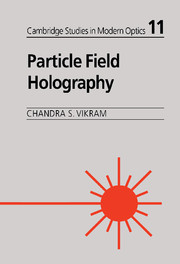Book contents
- Frontmatter
- Contents
- Foreword
- Preface
- Acknowledgements
- 1 Historical background
- 2 Introduction to holography
- 3 General theory of in-line Fraunhofer holography
- 4 System design considerations
- 5 Practical considerations
- 6 Analysis of reconstruction
- 7 Aberrations and their control
- 8 Hologram fringe-contrast and its enhancement
- 9 Non-image plane analysis
- 10 Velocimetry and high speed holography
- 11 The off-axis approach
- References
- Index
7 - Aberrations and their control
Published online by Cambridge University Press: 13 October 2009
- Frontmatter
- Contents
- Foreword
- Preface
- Acknowledgements
- 1 Historical background
- 2 Introduction to holography
- 3 General theory of in-line Fraunhofer holography
- 4 System design considerations
- 5 Practical considerations
- 6 Analysis of reconstruction
- 7 Aberrations and their control
- 8 Hologram fringe-contrast and its enhancement
- 9 Non-image plane analysis
- 10 Velocimetry and high speed holography
- 11 The off-axis approach
- References
- Index
Summary
The paraxial approximation or first-order optics considered so far in the analysis for determining the image coordinates and magnification (Chapter 6) is sufficient for many applications. As the minimum required effective hologram aperture increases for smaller objects, the aberrations must be considered for accurate imaging and analysis. This chapter is devoted to the general background development for third-order aberrations dealing with particle field holography. The in-line method is considered in more detail due to its widespread use. The reference source, the object and the hologram center points form a straight line in the in-line method, leading to interesting aspects of aberrations and their control. Cylindrical test-sections with curved windows are also encountered in practical far-field holography. Cylindrical ampules, water tunnels, etc. are, in effect, cylindrical lenses resulting in unwanted astigmatism. Ways to neutralize the cylindrical lens are therefore also discussed in the chapter.
Primary aberrations
For determining the coordinates of the image point (Chapter 2), the object, reference and reconstruction beams were assumed to be spherical over the hologram aperture. This approximation neglected higher order terms in the phase expressions of the wavefronts. Since particle field holography deals with very small objects, the aberration allowances are also small. In the presence of aberrations, diffraction-limited resolution may not be obtained.
From the discussion of Chapter 2, the ideal image point will form a spherical phase term over the hologram aperture with its center at the image point.
- Type
- Chapter
- Information
- Particle Field Holography , pp. 138 - 166Publisher: Cambridge University PressPrint publication year: 1992



